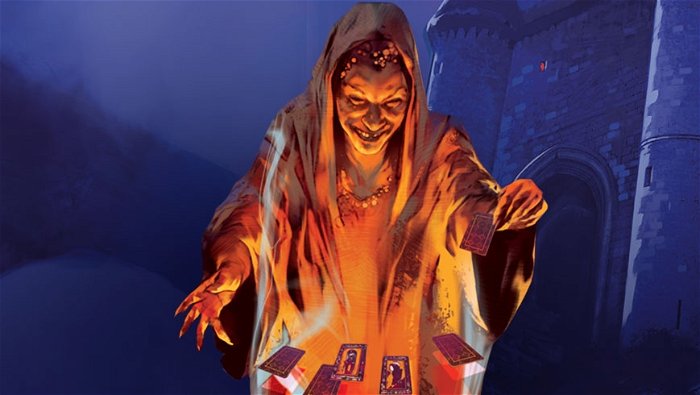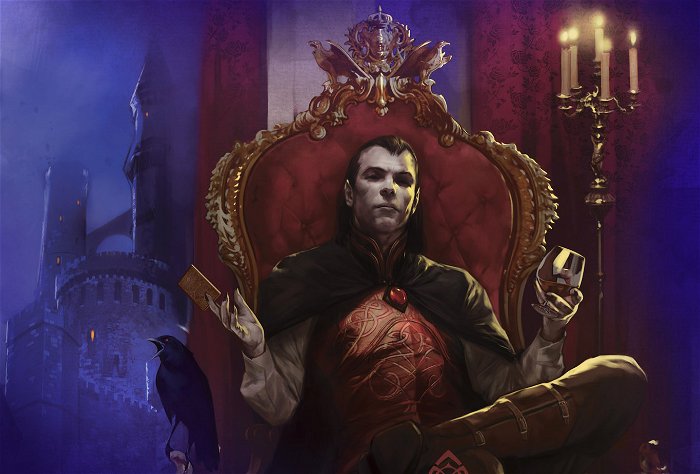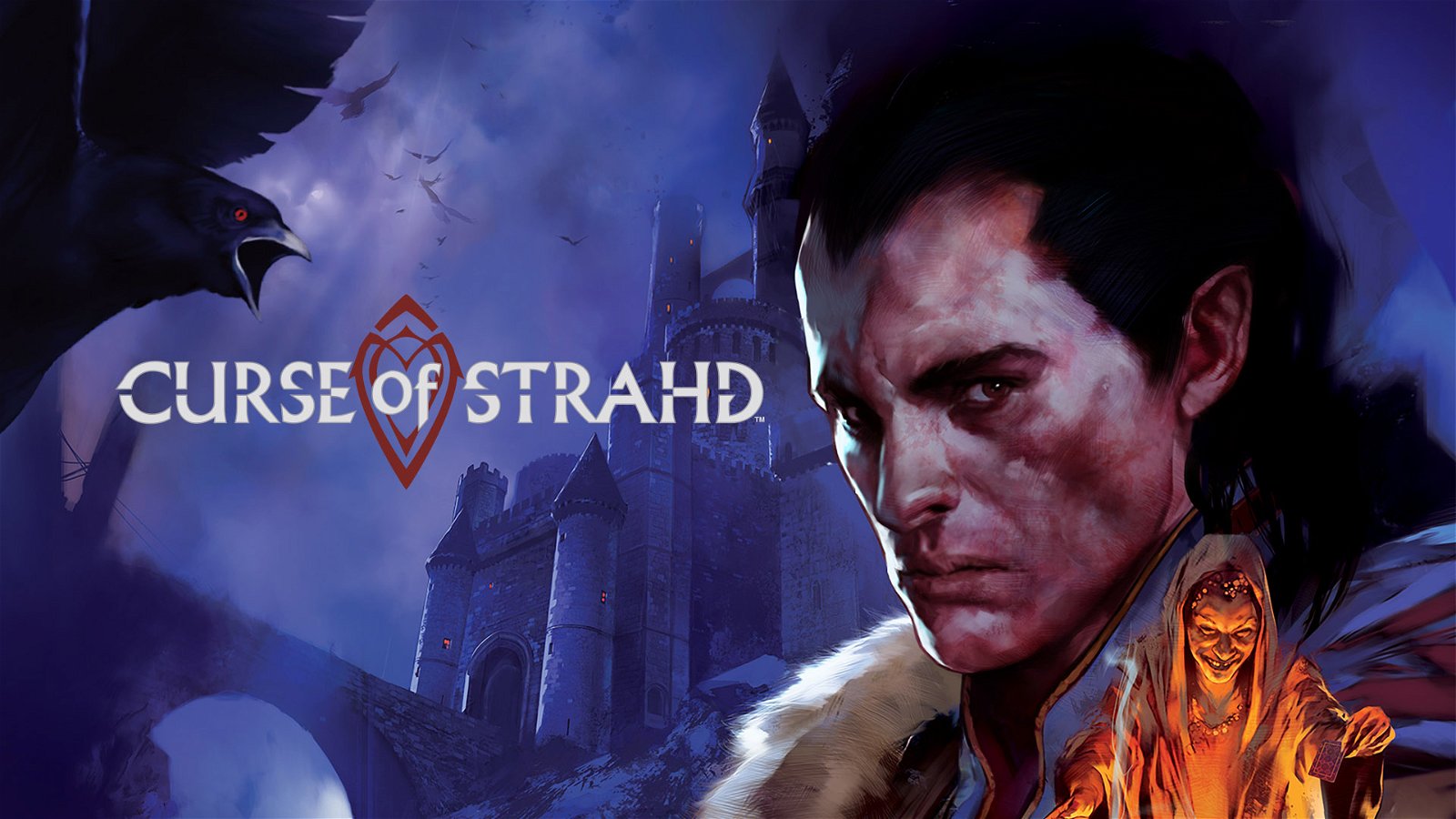When most people hear the words “multiplayer gaming”, they think of videogames. Back in 1974 however, before the first arcade and console boom, Dungeons and Dragons tabletop role-playing gave players a multiplayer experience that has gone on to inspire single-player RPGs that simulate a multiplayer experience, and, of course, MMORPGs like Ultima Online, Everquest and World of Warcraft.
One of the most intense tabletop role-playing modules ever was Ravenloft, a Gothic Horror setting that became one of the most memorable Advanced Dungeons and Dragons modules of the 1980s. The twist of Ravenloft was that both players and the Dungeon Master were influenced by five cards drawn at random from a deck at the beginning of play. These cards determined the locations inside Castle Ravenloft of two magical weapons, an important book that gave the players the antagonist’s backstory, and the location and motivation of the primary villain, the vampire Lord Strahd von Zarovich.
Adding to the fun was a feature where if a player had their fortune told at the in-game gypsy camp, all the cards were redrawn, and the Dungeon Master had to adapt.

Created by Laura and Tracy Hickman, Ravenloft’s random element tested players’ role-playing skills in a unique way. Ravenloft is a uniquely humbling, bonding experience, with a hard-wired collaborative spin that discourages the drama that grows in some other Gothic Horror RPGs. You had to essentially forget what you knew of Strahd in previous play sessions, because critical motivations could change at random.
I still remember how I was introduced to Ravenloft. A friend said: “Hey, want to play Ravenloft? It’s a D&D horror setting where we fuck with each other’s heads for fun”. Ravenloft actually lived up to that sales pitch.
It’s important to remember that “multiplayer” gaming can mean co-operative experiences as well as competitive ones, and the March 15
release of a new Dungeons and Dragons Ravenloft adventure, “Curse of Strahd” gave me an opportunity to talk to game designer Chris Perkins via email about Dungeons and Dragons, Ravenloft, and Lord Strahd himself.
Comics & Gaming Magazine: Ravenloft has a special place in D&D player’s hearts. It’s a campaign setting that is challenging not just for players, but for Dungeon Masters as well. Why did you bring back Ravenloft now?
Chris Perkins: The original Ravenloft adventure warms my cold, dark heart. I wanted to introduce new players to Strahd von Zarovich, a classic D&D antagonist, and his infamous castle. Also, I wanted to back up a statement we made to D&D players when we released the fifth edition core rulebooks: that D&D is a multiverse composed of many worlds and planes. After several stories set in the Forgotten Realms, the time seemed right to revisit “the Demiplane of Dread.”
CGM: Strahd von Zarovich was, at least in my awareness, one of the first great big bad Final Boss type characters in D&D games. He’s crazy powerful, and yet he’s doomed to fail over and over regarding the one thing he really wants. Why is a great villain important to party-based role-playing games?
CP: Strahd represents power and corruption. Adventurers by their very nature also represent power and, potentially, corruption. A good villain is in some ways a dark reflection of the heroes. When faced with such an antagonist, the characters feel like they have a connection to him. The original Ravenloft did such a good job of making sure that the DM plays Strahd the same way the players run their characters: with the goal of keeping him on his feet (I was about to say “alive”) for as long as possible.
CGM: How is this game a new adventure, as opposed to a retelling of Strahd’s story for a new generation of D&D players?
CP: Curse of Strahd combines elements of the original adventure with new material that illustrates Strahd’s impact on the lands and people around him. We learn more about the tragic people of Barovia, and we get to see how their horrible lives tie back to Strahd von Zarovich. Curse of Strahd adds depth to Strahd’s story and introduces new characters and new locations—dark places for the heroes to explore and learn more about Strahd’s past.

CGM: Strahd seems to have had a visual makeover. Is this a sign that you’re pulling further away from the Dracula proxy he began as?
CP: The Hickmans envisioned Strahd differently than he’s depicted in the original Ravenloft adventure. Their image didn’t match the Bela Legosi vampire quite so much. Tracy found an old daguerreotype [an early type of photograph captured on a silvered copper plate] that captured the look of Strahd in his mind, and we used that image as a reference to create a new look for the vampire.
CGM: How does the new [supplemental] Madam Eva’s Tarokka deck integrate with the experience?
CP: Madam Eva’s Tarokka cards work like the cards in the original Ravenloft adventure. With a single card reading, Madam Eva can tell adventurers where they must confront Strahd, as well as the locations of several artifacts that can help them defeat the vampire. The cards add a fun randomization element to the adventure.
CGM: Was it always a goal to involve original creators Tracy and Laura Hickman? What was their reaction to going back to something they originally wrote in 1983?
CP: Without the Hickmans, this project would’ve died on the vine. When I told them that we wanted to revisit Ravenloft, they were thrilled to be involved. Tracy had been DM’ing the adventure for friends and family for the past three decades, and he had lots of ideas of things we could add to the story.
CGM: Many video games like Bloodborne are now dealing with Gothic horror themes surrounding a displaced realm with a castle or tower in the center, and the Elder Scrolls games deal with dark powers similar to Ravenloft. But those are solitary digital experiences and tabletop D&D is something designed to be played with friends in person. How does this impact the way you approach the adventure?

CP: These video games didn’t impact my approach to Curse of Strahd. I’ve never played Bloodborne or The Elder Scrolls, so those games had no influence on me. However, it doesn’t surprise me that Ravenloft has helped to create a new storytelling trope. My goal with Curse of Strahd was to make an adventure that the Hickmans would be proud of—something Tracy could run for the next three decades.
CGM: I have a love/hate relationship with the amount of trust that really great role-playing requires. I love it when it works. I hate it when people abuse that trust. What does it take to be a great tabletop role-player?
CP: When one sits down to play a tabletop RPG, there’s an unspoken social contract that the players and the DM must respect. The social contract states that the DM will run a fair and fun game. It also dictates that the players will contribute to the game in a positive way and not make the experience miserable for anyone else. A good role-player honours the social contract. A truly great one also brings something special to the game, such as an inventive mind, a gift for characterization, mad improvisational skills, or something else.
CGM: What, in your option, do tabletop role-playing games do that video games still can’t replicate?
CP: The advantage that Ravenloft and Curse of Strahd have over their video game counterparts is that there are no limits to what DMs and players can do at the game table. D&D tabletop adventures are not constrained by programming or the imaginations of their designers.
CGM: One of the greatest lessons D&D ever taught me was that people come in different belief systems, different alignments, and different skills. I like to organize the people I know into D&D classes, and still make characters sheets for characters where I have to write “in voice”. What skills does tabletop role-playing strengthen that you’ve found have helped you in real life?
CP: Tabletop roleplaying has improved my ability to tell stories and think on my feet. It’s given me the power to see the world through different eyes, appreciate other points of view, and collaborate with others to solve problems. When I was young, it also helped my vocabulary, math skills, and social skills. That’s pretty remarkable for one game!
Note: some additions have been made to this interview for clarity. They are indicated by squared brackets.




